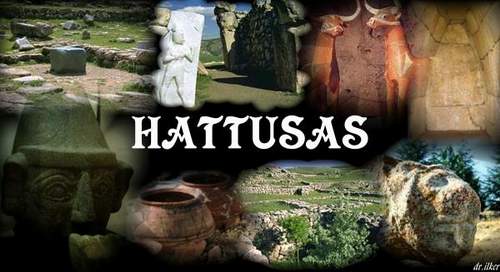|
HATTUSAS
The historical site of Boğazköy (Hattusas) is located at 82 km. to the southwest of Çorum and it is 208 km. from Ankara.
Boğazköy (Hattusas) site which was located at the core region of the Hittite state is at the southern end of the Budaközü River
valley, at an elevation of 300 meters from the plain surrounded by numerous rock masses and the seperations of mountain sides
and deep clifts to the north and west. The city is open towards the north and surrounded by city walls on all sides except the
north.
Hattusas was the capital of the Hittite empire in the 2nd millenium BCE. The city was located on a mountain slope at the southern end of a small fertile plain. It lay between two deeply-cut streams which converged on the plain (at an elevation of about 3,100 ft), forming the northernmost point of the city. The city then stretches to the south, rising about 1000 feet over a distance of 1-1/4 miles. In some places the eastern valley narrows to a deep gorge. It seems surprising that such a remote city could have been the capital of an empire, but besides tradition there were the factors of plentiful water and good natural defenses that kept the Hittite kings there.
The first settlement at the site dates from the Early Bronze Age, but no documents exist that could identify the people who built them. They lived on the top and northwest foot of the high hill which dominates the east side of the city, called Büyükkale ("Great Fortress"). This hill later became the Hittite Acropolis.
The first writing from the site are clay tablets with Old Assyrian cuneiform. These demonstrate the presence of Assyrian merchants at the city, then called Hattus, around 1800 BCE. The largest Assyrian trading center in Anatolia was at Kanesh, which flourished from 1950 BCE to 1850 BCE (end of First Intermediate Period and beginning of Twelfth Dynasty), was destroyed, and then became active again around 1820 BCE and lasted another two generations (late 12th Dynasty). Assyrian trading at Hattusas is contemporary only with the later period.
The early settlers of Hattus spoke a language with the same name. It belongs to no other known family and scholars call it Hattic to distinguish it from Hittite. Hittite is an Indo-European language and probably arrived with Indo-European conquerors, although details of this "conquest" are lacking. Indo-European names appear at Kanesh before 1850 BCE, and it is possible that the native Hattic people made up the ruling class or even the entire population during this period, but this cannot be proven. The merchants lived in the lower part of the city, which extended up to the great hill, whereupon the king's palace was probably located. The entire city was destroyed, probably by a King Anittas of Kussara sometime after 1800 BCE. A Hittite text supposed to have been written by him describes his conquests in Anatolia, noting he destroyed Hattusas, killed its King Piyusti, and cursed the city's site.
The Indo-Europeans added an a to the city's name and declined it according to their own language, giving it the nominative form Hattusas. The first mention of the name in that form is in a tablet from Mari, on the middle Euphrates, from the time of Hammurabi (1792-1750 BCE, end of the Twelfth Dynasty). This may be a reference to the city before its destruction.
|





